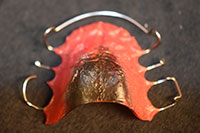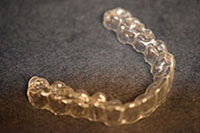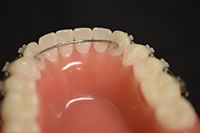Orthodontic Retention
You've Worked Hard for Your Beautiful Smile; Keep it That Way!
Finally, your braces have been removed and your smile is beautiful and straight! However, your orthodontic journey isn't quite completed. To keep your smile looking its best, you'll have to wear a retainer to preserve and stabilize your results. Retainers are needed to control or limit potential changes in tooth position. They are used after orthodontic treatment to hold teeth in their correct alignment while the surrounding gums, bone, and muscle adjust to the new positioning of your teeth. Retainers are custom-made and can be removable or bonded depending on what Dr. Sayre feels is the best option for your particular case.
Types of Retainers
 Hawley retainers typically include a metal wire that surrounds the front teeth and is attached to an acrylic arch that sits in the roof of the mouth. The metal wires can be adjusted to finish closing spaces and continue minor movement of the front teeth as needed.
Hawley retainers typically include a metal wire that surrounds the front teeth and is attached to an acrylic arch that sits in the roof of the mouth. The metal wires can be adjusted to finish closing spaces and continue minor movement of the front teeth as needed.
 Clear retainers or Essix retainers, look similar to aligners and offer a more aesthetic alternative to wire retainers. This clear retainer fits over the entire arch of your teeth. It is made from a scan of your newly aligned teeth.
Clear retainers or Essix retainers, look similar to aligners and offer a more aesthetic alternative to wire retainers. This clear retainer fits over the entire arch of your teeth. It is made from a scan of your newly aligned teeth.
 Bonded retainers consist of wires bonded behind the bottom and/or top teeth. While the wire is usually required no more than a year after wisdom teeth have been extracted, it is often kept in place for the rest of your life or as long as you want your teeth straight as we say!
Bonded retainers consist of wires bonded behind the bottom and/or top teeth. While the wire is usually required no more than a year after wisdom teeth have been extracted, it is often kept in place for the rest of your life or as long as you want your teeth straight as we say!
Things to Remember About Your Retainers:
- Removable retainers should be taken out for eating and hygiene routines.
- Removable retainers can get lost easily, so remember to keep yours in the case whenever you remove it to eat or brush.
- A bonded retainer is great if you don't want to keep track of it, or if you don't want to worry about how many hours per day it must be worn.
- Teeth with bonded retainers require a little extra attention to remove tartar while flossing. Patients often must use floss threaders to pass dental floss through the small spaces between the retainer and the teeth.

